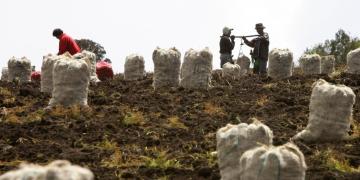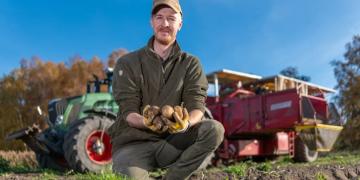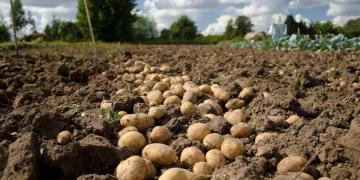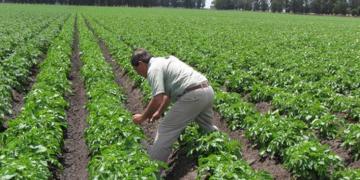Canadá: Production Projections
Statistic Canada’s potato acreage estimates are similar to last year but a strong start in most provinces has growers feeling optimistic.
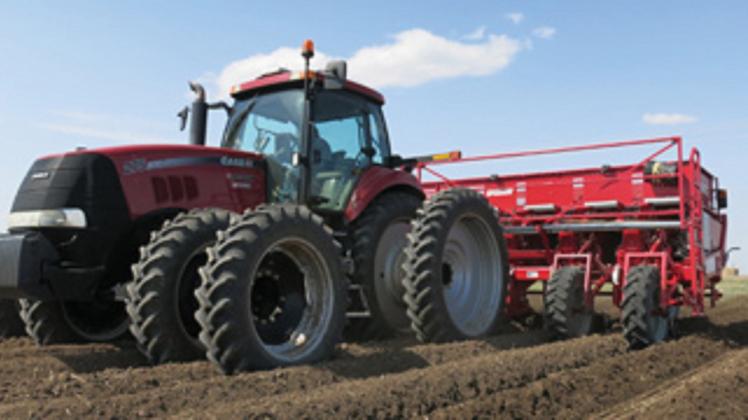
Favourable conditions in most growing regions this spring, a dip in the value of the Canadian dollar and some increases in processing contracts have potato producers across the country feeling optimistic about the 2015 season.
Statistic Canada’s production estimates for 2015 released on July 17 show the total planted acreage in Canada as 349,005 acres. Overall, this represents an increase of 1,465 acres from 2014, a 0.4 per cent rise. Contributing to the slight increase is a bump up in some processing contracts, especially in Manitoba where the planted potato acreage is up 4,000 acres from last year.
The fact that processing companies and french fry producers have given additional volume to some provinces is largely due to where the Canadian dollar is today compared to a year ago, says Kevin MacIsaac, general manager of United Potato Growers of Canada.
“It’s more profitable running those plants harder in Canada than it is for those same companies to run them in the U.S.,” MacIsaac told Spud Smart in June. “It [the Canadian dollar] has a big effect. [Companies] have the ability to shift the processing of raw product back and forth and they certainly look and see which [factories] are the most efficient and profitable for them to run.”
MacIsaac said it’s too early to tell what impact the lower Canadian dollar will have on shipments to the U.S., but added there is potential for export growth. Canadian exports to the U.S. tend to depend on how much the Americans ship to other countries, especially in the Asian market. The flow of U.S. potatoes to Asia was slowed last year due to the West Coast port strike, but could increase this year now that the issue has been resolved, MacIsaac said.
MacIsaac noted it’s difficult at this time to pinpoint prices for this season. He added that as of mid-June, prices in Western Canada were right about where they should be, while prices in Eastern Canada were well below where they should be because of sizable inventories in the East and the U.S.
Still, MacIsaac is optimistic that prices will hold stable and might even increase as those surpluses are reduced and new crops become available. A similar glut in Europe and reductions in the number of acres planted there could also bode well for Canadian growers because “[Canada] competes with those countries … [and] we just had too much product in those markets a year ago,” he said.
Eastern Canada — especially the Atlantic region — suffered through one of the worst winters in recent memory, which significantly delayed planting in several provinces this spring. MacIsaac said that could actually turn out to be a positive for growers.
“A big part of the country does not have an early crop coming on,” he said. “That will be good and will allow us to clean up our existing old crop, whereas if it was the opposite it would be a problem because we’d have early potatoes coming on before the old ones were done marketing. It extends [the market for existing product] and that’s good for us.”
New Brunswick
Potato acreages in New Brunswick are down slightly by 265 acres to a total of 47,885 acres. About 60 per cent of those potatoes will be destined for processing with the rest split almost evenly between seed and fresh potatoes.
Louis Ouellette, market information co-ordinator for Potatoes New Brunswick, said in June that contract volumes were expected to remain stable after being cut by nearly 15 per cent last year.
New Brunswick’s planting season started nearly two weeks later than usual due to last winter’s heavy snowfall and a touch of frost this spring, noted Ouellette. “It was just a slow start,” he said, adding that if the weather remained favorable into July, “we have a good chance of catching up.”
Ouellette said he expects this year’s yield to be similar and possibly even slightly higher than last year’s cut weight-per-acre total of 300 hundredweight. While a few cases of blight might appear, he said he doesn’t anticipate disease will be a major concern for growers this season.
Prince Edward Island
The total planted potato acreage in Prince Edward Island is 89,500 acres, a 1,000-acre or -1.1 per cent drop from last year. According to P.E.I. Potato Board Chair Alex Docherty, the slight dip can be attributed mainly to economics and market forces.
Docherty said in June that planting in P.E.I. was delayed by at least 10 days this spring due to heavy snowfall from last winter. The eastern end of the island experienced the most severe delays, he added.
“The biggest trouble is the long-season variety. You’re going to run into a later harvest,” Docherty said. “[But] Mother Nature can do wonders for us. Last year we thought we were in a bit of a bind and then we dug probably one of the highest quality crops we ever dug.”
Despite the late start, Island growers can expect a typical yield this year, Docherty said, and it could be a great one if the weather co-operates. There are no major health concerns at this stage and yield quality could be very high depending on weather, he added.
Quebec
In Quebec, potato acreage was down 247 acres to about 42,749 total acres, due largely to a reduction in table acreages.
Planting in la belle province got off to a much earlier start this year compared to 2014, according to Clement Lalancette, director general of le Fédération des producteurs de pommes de terre du Québec. The fact that planting began seven to 10 days earlier than last year is reason for optimism, he told Spud Smart in June.
“Most of the seeds were in the ground by the second week of June except for the northern area of the province. It looks like a regular start to the season,” Lalancette said.
Lalancette said he expects yields to be similar to last year. He noted the disease outlook for the 2015 crop looks good, but added scabbing could be an issue.
Ontario
The potato acreage in Ontario is down 750 acres to 34,750 acres this year.
Peter VanderZaag, a noted potato researcher and owner of Sunrise Potatoes said in June he was encouraged by the start to the 2015 season. “Our contracts were all effectively very stable for chip stock, which is our main business out here. That was good news. The last few years, we had been reduced by about five per cent contract cuts,” he said.
According to VanderZaag, planting started on time and was unimpeded in most parts of the province due to favourable conditions. The only concern was dry conditions meant variability in growth rates, with some plants just emerging from the ground with others already more than a foot in height.
“The variation in plant stand … is not a good thing for chip stock. They will mature at a later time and if they mature too late … then they won’t fry well. It’s a matter of sugar content in the tuber,” VanderZaag said.
VanderZaag said he is optimistic about yield potential in the province, and added it could be a “fantastic” year if the good weather in June lasted throughout the summer. His only concern was the return of late blight which had a serious impact last year, but VanderZaag noted that warm, dry weather would help reduce the likelihood of that.
Manitoba
Manitoba is the country’s big gainer 2015, with total acreage in the province up 6.3 per cent this year to 67,000 acres. Dan Sawatzky, manager of the Keystone Potato Producers Association, said in June that a surge in demand by processors was behind the increase.
According to Sawatzky, planting in Manitoba got off to a much better start this spring than it did a year ago when it was delayed by as much as 10 days in some parts of the province due to cool, wet conditions. With the exception of central Manitoba, planting began right on schedule this year, he said.
“Early on it’s looking like the potential of having a decent crop is there, both in terms of yield and quality. I believe there is [reason for optimism],” Sawatzky said.
Saskatchewan
In Saskatchewan, potato acreage is down 413 acres to 6,000 acres.
According to MacIsaac, there were favourable conditions for planting this spring, meaning many Saskatchewan growers were able to start planting much sooner than they had the previous couple of years.
Alberta
Potato acreage in Alberta is up 475 acres to 53,459 acres in 2015.
Terence Hochstein, executive director of the Potato Growers of Alberta, said in June that dollar values for most processing contracts are up this year. He added Alberta had one of the best planting seasons ever this spring and growers were up to two weeks ahead of where they were at the same time last year.
British Columbia
In British Columbia, potato acreage is down 190 acres to 5,700 acres this year.
Decent weather allowed growers to begin planting on time this spring, according to MacIsaac. He added that if the weather held, B.C. growers could expect a comparable yield in terms of quantity and quality.
Fuente: http://www.spudsmart.com/past-issues

